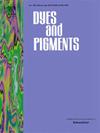Overcoming surface quenching in persistent luminescence nanoparticles with organic ligand coordination: Implications for enhanced optical imaging
IF 4.1
3区 工程技术
Q2 CHEMISTRY, APPLIED
引用次数: 0
Abstract
Persistent luminescence nanoparticles (PLNPs) have been considered as excellent luminescent tools for sensitive optical imaging. However, the persistent luminescence (PL) properties of PLNPs are usually suppressed due to severe surface quenching caused by nanoscale size. Despite considerable efforts, the understanding of surface quenching mechanisms remains a challenge. Here we report a surface ligand coordination method to enhance the PL properties of ZnGa2O4:Al,Cr (ZGO:AC) PLNPs. ZGO:AC PLNPs coated with organic ligands containing carboxyl groups show enhanced PL intensity and prolonged decay time. Among the six ligands, the phthalic acid (PA) ligands yielded the largest luminescence enhancement effect, on which the PL intensity and decay time increased 3 and 2 times compared with ligand-free ZGO:AC PLNPs, respectively. Density functional theory (DFT) calculations and detailed characterizations demonstrated that surface quenching is suppressed due to the coordination of non-saturated Ga ions and -COO- of ligands. Finally, ZGO:AC@PA PLNPs were applied in autofluorescence-free bioimaging and exhibited high imaging sensitivity and contrast ratio. These findings provide insights into the surface quenching mechanisms of PLNPs and offer a platform for developing highly emissive PLNPs on nanoscale.
利用有机配体配位克服持续发光纳米粒子的表面淬火:对增强光学成像的影响
持久发光纳米粒子(PLNPs)一直被认为是灵敏光学成像的绝佳发光工具。然而,由于纳米尺寸造成的严重表面淬火,PLNPs 的持续发光(PL)特性通常会受到抑制。尽管做了大量努力,但对表面淬火机制的理解仍然是一个挑战。在此,我们报告了一种表面配体配位方法来增强 ZnGa2O4:Al,Cr (ZGO:AC)PLNPs 的光致发光特性。镀有含羧基的有机配体的 ZGO:AC PLNPs 显示出更强的聚光强度和更长的衰减时间。在六种配体中,邻苯二甲酸(PA)配体的发光增强效果最好,与不含配体的 ZGO:AC PLNPs 相比,其发光强度和衰减时间分别增加了 3 倍和 2 倍。密度泛函理论(DFT)计算和详细表征表明,由于非饱和镓离子和配体的-COO-配位,表面淬灭被抑制。最后,ZGO:AC@PA PLNPs 被应用于无自荧光生物成像,并表现出很高的成像灵敏度和对比度。这些发现深入揭示了 PLNPs 的表面淬火机制,并为开发纳米级高发射性 PLNPs 提供了一个平台。
本文章由计算机程序翻译,如有差异,请以英文原文为准。
求助全文
约1分钟内获得全文
求助全文
来源期刊

Dyes and Pigments
工程技术-材料科学:纺织
CiteScore
8.20
自引率
13.30%
发文量
933
审稿时长
33 days
期刊介绍:
Dyes and Pigments covers the scientific and technical aspects of the chemistry and physics of dyes, pigments and their intermediates. Emphasis is placed on the properties of the colouring matters themselves rather than on their applications or the system in which they may be applied.
Thus the journal accepts research and review papers on the synthesis of dyes, pigments and intermediates, their physical or chemical properties, e.g. spectroscopic, surface, solution or solid state characteristics, the physical aspects of their preparation, e.g. precipitation, nucleation and growth, crystal formation, liquid crystalline characteristics, their photochemical, ecological or biological properties and the relationship between colour and chemical constitution. However, papers are considered which deal with the more fundamental aspects of colourant application and of the interactions of colourants with substrates or media.
The journal will interest a wide variety of workers in a range of disciplines whose work involves dyes, pigments and their intermediates, and provides a platform for investigators with common interests but diverse fields of activity such as cosmetics, reprographics, dye and pigment synthesis, medical research, polymers, etc.
 求助内容:
求助内容: 应助结果提醒方式:
应助结果提醒方式:


